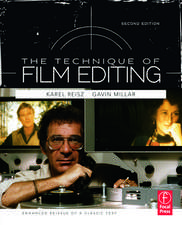Learning Blender: Learning
Autor Oliver Villaren Limba Engleză Paperback – 22 apr 2021
Follow a realistic 3D workflow through a complete project:
- An introduction to Blender will familiarize you with the interface, controls, how to interact with objects, and how to edit them.
- Simple exercises drill you on the basics of Blender so you're ready to approach the full project.
- Chapters cover every aspect of character design, allowing you to create a fully animated character.
- Lessons are tailored to skill and knowledge level, so readers new to 3D software can master the fundamentals while experienced users can jump directly to the exercise.
Preț: 243.77 lei
Preț vechi: 304.71 lei
-20% Nou
Puncte Express: 366
Preț estimativ în valută:
46.65€ • 48.41$ • 38.99£
46.65€ • 48.41$ • 38.99£
Carte disponibilă
Livrare economică 22 februarie-08 martie
Livrare express 11-15 februarie pentru 37.04 lei
Preluare comenzi: 021 569.72.76
Specificații
ISBN-13: 9780136411758
ISBN-10: 0136411754
Pagini: 448
Dimensiuni: 176 x 227 x 16 mm
Greutate: 0.61 kg
Ediția:3rd edition
Editura: Pearson Education
Seria Learning
ISBN-10: 0136411754
Pagini: 448
Dimensiuni: 176 x 227 x 16 mm
Greutate: 0.61 kg
Ediția:3rd edition
Editura: Pearson Education
Seria Learning
Notă biografică
Oliver Villar is a Blender Foundation Certified Trainer. He has has studied 3D since 2004 and used diverse commercial 3D software before stumbling onto Blender in 2008. Since then, he has used Blender professionally as a freelance 3D designer and tutor. In 2010, he founded blendtuts.com to offer high-quality Blender training videos to the community. He authored this book's first and second editions and the video, Introduction to Blender LiveLessons (Addison-Wesley, 2015). Villar is now co-directing Luke's Escape, a 3D animated short film made with Blender. He is also teaching Blender at online schools focused on teaching for the Spanish community and teaches 3D for online schools and the University of Murcia in Spain.
Cuprins
Preface xxv
Acknowledgments xxxi
About the Author xxxiii
Part I: The Basics of Blender 1
Chapter 1: What You Need to Know About Blender 3
What Is Blender? 3
Commercial Software Versus Open-Source Software 4
History of Blender 6
Blender Foundation and Blender Development 8
Who Pays for Blender's Development? 10
The Blender Community 10
Summary 11
Exercises 12
Chapter 2: Blender Basics: The User Interface 13
Downloading and Installing Blender 13
Using Blender with Recommended Hardware 13
Using Blender's User Interface 15
Understanding Areas and Editors 16
Using Workspaces 21
Getting to Know Blender's Interface Elements 23
Understanding the 3D Viewport 26
Navigating the 3D Scene 31
Selecting Objects 33
Understanding the 3D Cursor 35
Understanding Blender's User Preferences 37
Creating Your Own Startup File 39
Summary 40
Exercises 40
Chapter 3: Your First Scene in Blender 41
Creating Objects 41
Moving, Rotating, and Scaling 42
Arranging Objects in Your Scene 48
Naming Objects and Using Datablocks 49
Using Interaction Modes 51
Applying Flat or Smooth Surfaces 53
Working with Modifiers 54
Using Workbench, EEVEE, and Cycles 57
Turning On the Lights 62
Moving the Camera in Your Scene 62
Rendering 63
Summary 66
Exercises 66
Part II: Beginning a Project 67
Chapter 4: Project Overview 69
Three Stages of a Project 69
Defining the Stages 71
Making a Character-Creation Plan 73
Summary 74
Exercises 74
Chapter 5: Character Design 75
Character Description 75
Designing the Character 78
Adding Color 84
Finalizing the Design 85
Making Character Reference Images 86
Using Other Design Methods 88
Summary 89
Exercises 89
Part III: Modeling in Blender 91
Chapter 6: Blender Modeling Tools 93
Working with Vertices, Edges, and Faces 93
Making Selections 95
Using Mesh Modeling Tools 100
Using Modeling Add-Ons 120
Using Other Useful Blender Options and Tools 123
Summary 125
Exercises 125
Chapter 7: Character Modeling 127
What Is Mesh Topology? 127
Choosing Modeling Methods 129
Setting up the Reference Images 131
Modeling the Eyes 135
Modeling the Face 139
Modeling the Torso and Arms 150
Modeling the Legs 159
Modeling the Boots 161
Modeling the Hands 164
Modeling the Cap 168
Modeling the Hair 172
Modeling the Final Details 176
Summary 180
Exercises 180
Part IV: Unwrapping, Painting, and Shading 181
Chapter 8: Unwrapping and UVs in Blender 183
Seeing How Unwrapping and UVs Work 183
Unwrapping in Blender 184
Considering Before Unwrapping 191
Working with UVs in Blender 193
Unwrapping the Rest of the Character 200
Packing UVs 202
Summary 203
Exercises 204
Chapter 9: Painting Textures 205
Defining the Main Workflow 205
Texture Painting in Blender 206
Creating the Base Texture 214
Understanding the Elements of a Texture 215
Texturing in Other Software 216
Seeing the Painted Character in Blender 223
Summary 223
Exercises 224
Chapter 10: Materials and Shaders 225
Understanding Materials 225
Masks and Layers 230
Channels 231
Shading Your Character 236
Running Render Tests 246
Summary 252
Exercises 252
Part V: Bringing Your Character to Life 253
Chapter 11: Character Rigging 255
Understanding the Rigging Process 255
Working with Armatures 257
Rigging Your Character 267
Skinning 278
Creating Custom Shapes 305
Making Final Retouches 306
Reusing Your Character in Different Scenes 307
Summary 310
Exercises 310
Chapter 12: Animating Your Character 311
Using the Character's Rig 311
Posing the Character 312
Working with Animation Editors 315
Animating a Walk Cycle 321
Summary 326
Exercises 326
Part VI: Getting the Final Result 327
Chapter 13: Camera Tracking in Blender 329
Understanding Camera Tracking 329
Shooting Video for Easy Tracking 330
Using the Movie Clip Editor 332
Tracking the Camera Motion 333
Testing Camera Tracking 343
Summary 343
Exercises 343
Chapter 14: Lighting, Compositing, and Rendering 345
Lighting Your Scene 345
Rendering and Compositing Your Scene in Cycles 356
Rendering and Compositing Your Scene with EEVEE 361
Exporting the Final Render 365
Summary 367
Exercises 367
Part VII: Keep Learning 369
Chapter 15: Other Blender Features 371
Simulations 371
2D Animation 373
VFX: Masking, Object Tracking, and Video
Stabilization 373
Video Editing 374
Sculpting 374
Retopology 375
Maps Baking 375
Add-Ons 375
Python Scripting 376
Summary 376
Index 379
Acknowledgments xxxi
About the Author xxxiii
Part I: The Basics of Blender 1
Chapter 1: What You Need to Know About Blender 3
What Is Blender? 3
Commercial Software Versus Open-Source Software 4
History of Blender 6
Blender Foundation and Blender Development 8
Who Pays for Blender's Development? 10
The Blender Community 10
Summary 11
Exercises 12
Chapter 2: Blender Basics: The User Interface 13
Downloading and Installing Blender 13
Using Blender with Recommended Hardware 13
Using Blender's User Interface 15
Understanding Areas and Editors 16
Using Workspaces 21
Getting to Know Blender's Interface Elements 23
Understanding the 3D Viewport 26
Navigating the 3D Scene 31
Selecting Objects 33
Understanding the 3D Cursor 35
Understanding Blender's User Preferences 37
Creating Your Own Startup File 39
Summary 40
Exercises 40
Chapter 3: Your First Scene in Blender 41
Creating Objects 41
Moving, Rotating, and Scaling 42
Arranging Objects in Your Scene 48
Naming Objects and Using Datablocks 49
Using Interaction Modes 51
Applying Flat or Smooth Surfaces 53
Working with Modifiers 54
Using Workbench, EEVEE, and Cycles 57
Turning On the Lights 62
Moving the Camera in Your Scene 62
Rendering 63
Summary 66
Exercises 66
Part II: Beginning a Project 67
Chapter 4: Project Overview 69
Three Stages of a Project 69
Defining the Stages 71
Making a Character-Creation Plan 73
Summary 74
Exercises 74
Chapter 5: Character Design 75
Character Description 75
Designing the Character 78
Adding Color 84
Finalizing the Design 85
Making Character Reference Images 86
Using Other Design Methods 88
Summary 89
Exercises 89
Part III: Modeling in Blender 91
Chapter 6: Blender Modeling Tools 93
Working with Vertices, Edges, and Faces 93
Making Selections 95
Using Mesh Modeling Tools 100
Using Modeling Add-Ons 120
Using Other Useful Blender Options and Tools 123
Summary 125
Exercises 125
Chapter 7: Character Modeling 127
What Is Mesh Topology? 127
Choosing Modeling Methods 129
Setting up the Reference Images 131
Modeling the Eyes 135
Modeling the Face 139
Modeling the Torso and Arms 150
Modeling the Legs 159
Modeling the Boots 161
Modeling the Hands 164
Modeling the Cap 168
Modeling the Hair 172
Modeling the Final Details 176
Summary 180
Exercises 180
Part IV: Unwrapping, Painting, and Shading 181
Chapter 8: Unwrapping and UVs in Blender 183
Seeing How Unwrapping and UVs Work 183
Unwrapping in Blender 184
Considering Before Unwrapping 191
Working with UVs in Blender 193
Unwrapping the Rest of the Character 200
Packing UVs 202
Summary 203
Exercises 204
Chapter 9: Painting Textures 205
Defining the Main Workflow 205
Texture Painting in Blender 206
Creating the Base Texture 214
Understanding the Elements of a Texture 215
Texturing in Other Software 216
Seeing the Painted Character in Blender 223
Summary 223
Exercises 224
Chapter 10: Materials and Shaders 225
Understanding Materials 225
Masks and Layers 230
Channels 231
Shading Your Character 236
Running Render Tests 246
Summary 252
Exercises 252
Part V: Bringing Your Character to Life 253
Chapter 11: Character Rigging 255
Understanding the Rigging Process 255
Working with Armatures 257
Rigging Your Character 267
Skinning 278
Creating Custom Shapes 305
Making Final Retouches 306
Reusing Your Character in Different Scenes 307
Summary 310
Exercises 310
Chapter 12: Animating Your Character 311
Using the Character's Rig 311
Posing the Character 312
Working with Animation Editors 315
Animating a Walk Cycle 321
Summary 326
Exercises 326
Part VI: Getting the Final Result 327
Chapter 13: Camera Tracking in Blender 329
Understanding Camera Tracking 329
Shooting Video for Easy Tracking 330
Using the Movie Clip Editor 332
Tracking the Camera Motion 333
Testing Camera Tracking 343
Summary 343
Exercises 343
Chapter 14: Lighting, Compositing, and Rendering 345
Lighting Your Scene 345
Rendering and Compositing Your Scene in Cycles 356
Rendering and Compositing Your Scene with EEVEE 361
Exporting the Final Render 365
Summary 367
Exercises 367
Part VII: Keep Learning 369
Chapter 15: Other Blender Features 371
Simulations 371
2D Animation 373
VFX: Masking, Object Tracking, and Video
Stabilization 373
Video Editing 374
Sculpting 374
Retopology 375
Maps Baking 375
Add-Ons 375
Python Scripting 376
Summary 376
Index 379

























